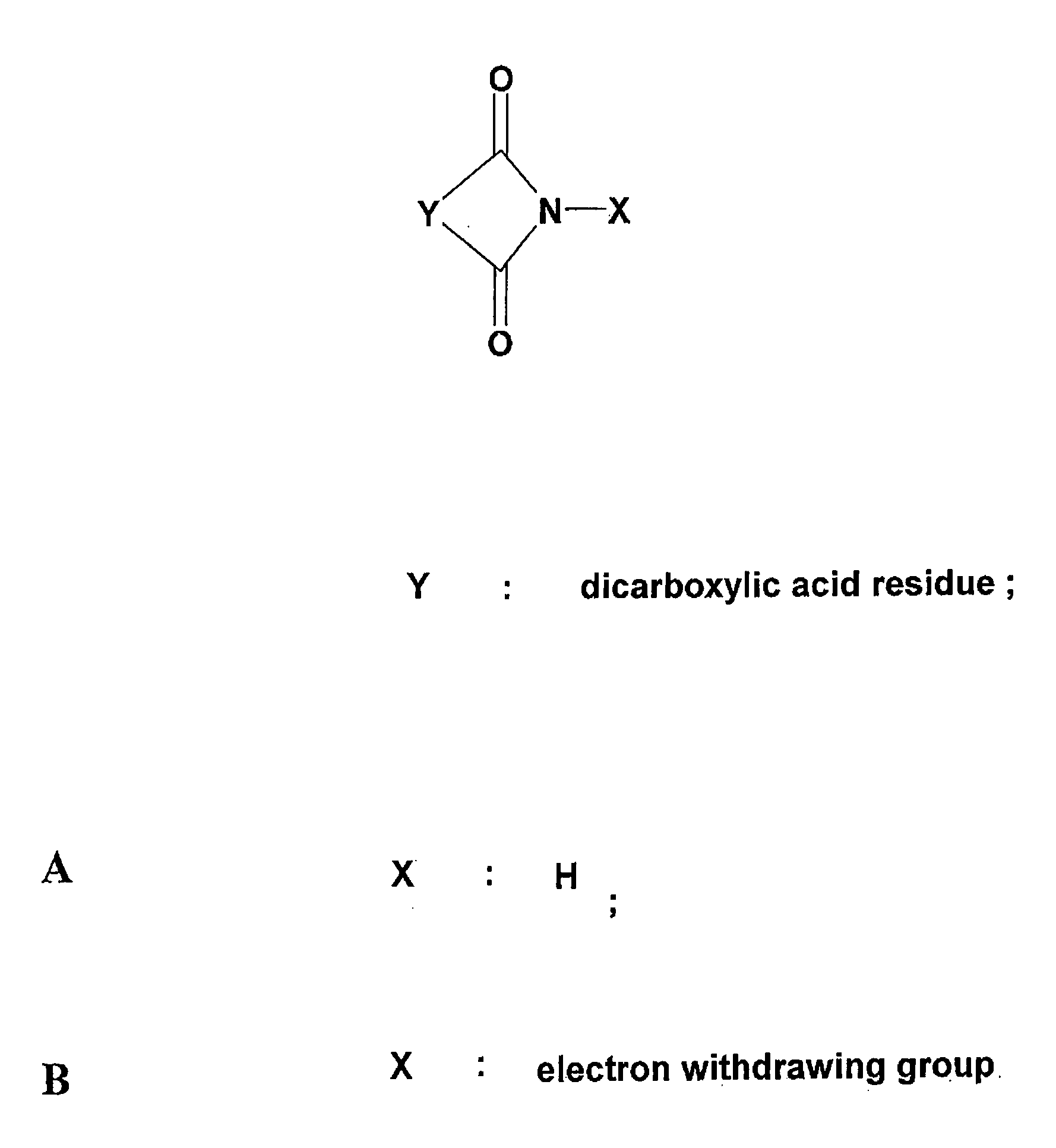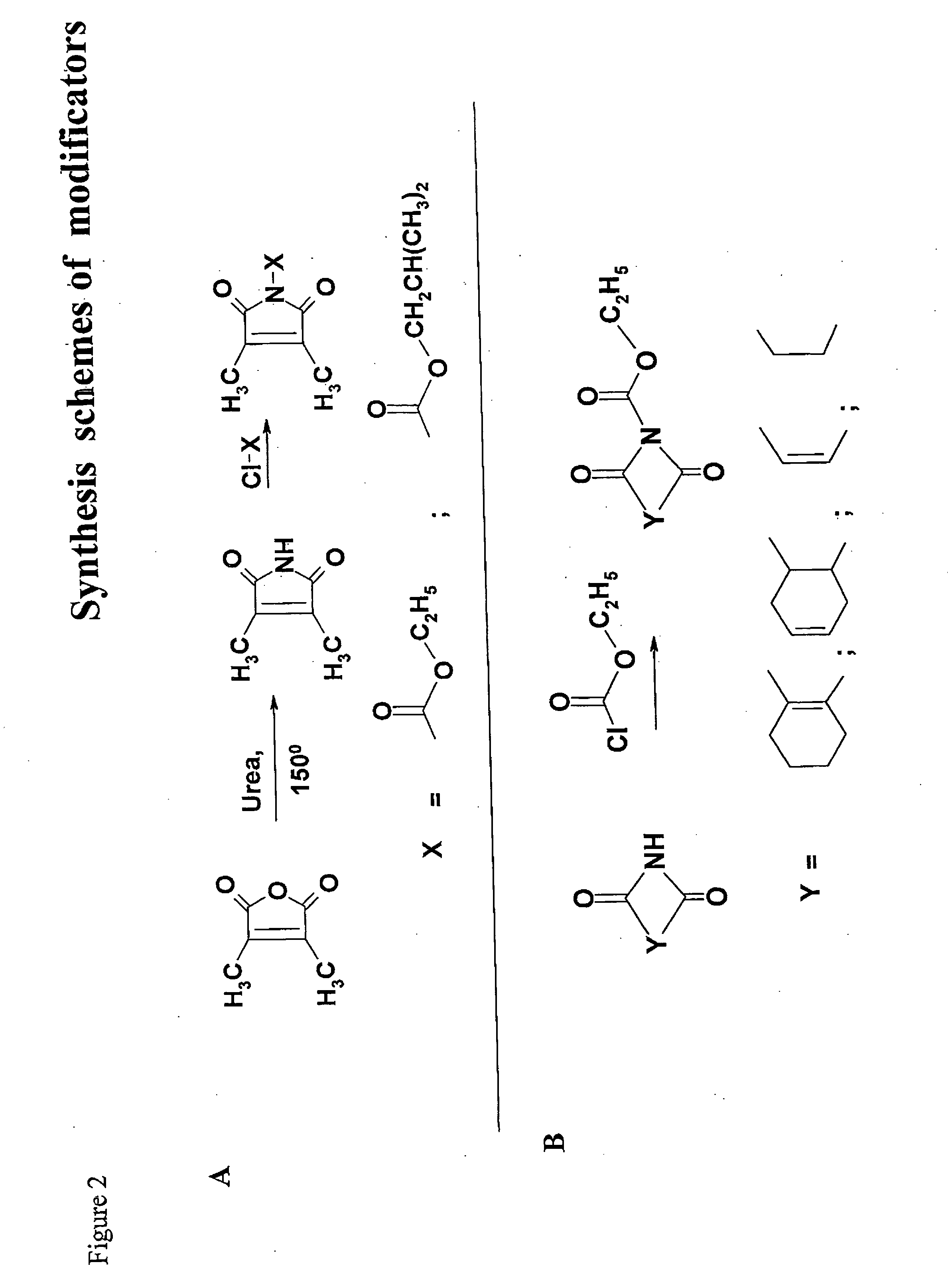Inactivation method
a technology of inactivation method and enzyme, which is applied in the direction of enzymes, biocide, plant growth regulators, etc., can solve the problems of reducing the efficiency of amplification of the desired sequence, and reducing the number of laborious, expensive and time-consuming approaches. to overcome difficulties, avoiding the formation of primer dimers, and reducing enzyme activity
- Summary
- Abstract
- Description
- Claims
- Application Information
AI Technical Summary
Benefits of technology
Problems solved by technology
Method used
Image
Examples
example 1
Synthesis of Putative Modificators
[0129] 2,3-dimethylmaleimide A mixture of 2,3-dimethylameic anhydride (2.5 g, 20 mmol), urea (1.2 g, 20 mmol) and sodium chloride (4.05 g, 70 mmol) was transferred to a flask fitted with an air condenser and was heated with stirring at 150° C. until the organic components were seen to fuse. Heating was continued for 30 min. Boiling water (10 ml) was then added. The cooled mixture was diluted with water (15 ml) and extracted (ethyl acetate, 4×30 ml). The combined organic layers were washed (sat.aq. NaCl, 20 ml), dried (Na2SO4) and concentrated in vacuum. The residue was crystallised from ethyl alcohol. Purification in chloroform and hexane on a silica gel column gave 2,3-dimethylmaleimide as a colourless crystalline solid (yield 79%).
[0130]1H NMR (CDCl3) δ 1.99 (6H, s, 2×CH3).
[0131] N-Ethoxycarbonyl-2,3-dimethylmaleimide. Ethyl chloroformate (1.5 ml, 15.6 mmol) was added dropwise to a stirred solution of 2,3-dimethylmaleimide (1.5 g, 12 mmol) and...
example 2
Polymerase Activity Assays
[0144] The measure of the enzyme activity was incorporation of [3H]-dTTP into polynucleotide fraction. One unit of polymerase activity is defined as the enzyme amount which incorporates 10 nmoles of deoxyribonucleotides into the polynucleotide adsorbed on DE-81 in 30 min at 70° C.
[0145] For activity assays, Taq DNA polymerase was diluted up to 4 u / ml with the dilution buffer of the following composition: 20 mM Tris-HCl (pH 8.8 at 25° C.), 1 mM EDTA, 1 mM DTT, and BSA (0.1 mg / ml). Reactions were carried out at 70° C. for 30 min with 5 μl of the diluted enzyme in 50 μl of the reaction buffer of the following composition: 67 mM Tris-HCl (pH 8.8 at 25° C.), 50 mM NaCl, 6.7 mM MgCl2, 1 mM DTT, and BSA (0.1 mg / ml). The reaction buffer was supplemented with 0.2 mM dNTP, [3H]-dTTP (0.4 MBq / ml) and 0.75 mM activated DNA from calf thymus.
[0146] Activity of the modified enzymes was measured either with the pre-incubation step, or without it, for 10 min at 95° C. i...
example 3
Modification of Taq DNA Polymerase with N-ethoxycarbonyl-2,3-dimethylmaleinimide
[0147] Recombinant Taq DNA polymerase was used at initial concentration of 10.8 mg / ml (800000 u / ml; ˜0.12 mM). An aliquot (80 μl) of the enzyme solution was dialyzed against 1000-fold volume of the dialysis buffer [100 mM H3BO3—NaOH (pH 8.5 at 25° C.)] for 24 hours at 4° C. About 350 μl of the enzyme solution were recovered after dialysis. The enzyme concentration was close to 0.037 mM.
[0148] A set of N-ethoxycarbonyl-2,3-dimethylmaleinimide solutions (736 mM, 368 mM, 184 mM, 92 mM, 63.25 mM, 46 mM and 23 mM) was prepared by serial dilutions of the 184 mM stock in N,N dimethylformamide (DMF).
[0149] Aliquots (35 μl) of the enzyme solution were mixed with 2.25 μl aliquots of the N-ethoxycarbonyl-2,3-dimethylmaleinimide solutions described above resulting in the following molar ratios of Taq DNA polymerase to N-etoxycarbonyl-2,3-dimethylmaleinimide: 1 / 1280 1 / 640, 1 / 320, 1 / 160, 1 / 110, 1 / 80, 1 / 40. The mix...
PUM
| Property | Measurement | Unit |
|---|---|---|
| temperatures | aaaaa | aaaaa |
| temperatures | aaaaa | aaaaa |
| temperatures | aaaaa | aaaaa |
Abstract
Description
Claims
Application Information
 Login to View More
Login to View More - R&D
- Intellectual Property
- Life Sciences
- Materials
- Tech Scout
- Unparalleled Data Quality
- Higher Quality Content
- 60% Fewer Hallucinations
Browse by: Latest US Patents, China's latest patents, Technical Efficacy Thesaurus, Application Domain, Technology Topic, Popular Technical Reports.
© 2025 PatSnap. All rights reserved.Legal|Privacy policy|Modern Slavery Act Transparency Statement|Sitemap|About US| Contact US: help@patsnap.com



